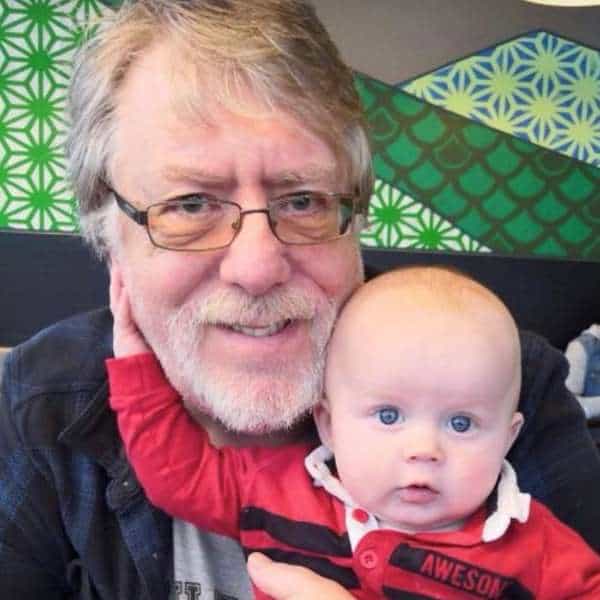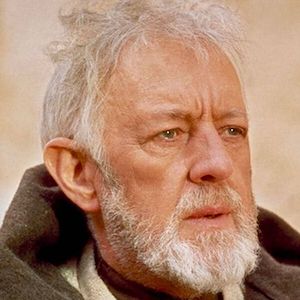
I think, by now, that anyone who’s read more than a couple of my previous articles will be used to me saying something along the lines of “Ah yes. Fred Bloggs. You’ll probably know him from some huge and relatively recent film. However, I remember him from something much earlier because I’m exceptionally old.”
So you won’t be surprised when I start on about how I was a fan of Alec Guinness from way before Star Wars, as it was called back then, was even a glimmer in George Lucas’ imagination. Indeed, I fondly remember him as a star of the Ealing Comedies, some of which are actually older than I am. But there’s a bit to say about Sir Alec before that.
Join the PERA (Personal Entertainment Research Assistant) waitlist.
The World's Most Indispensable Movie App
The RunPee app tells you the best times to
run & pee during a movie
so you don't miss the best scenes.
Download the RunPee app.
100% free (donation supported)
I Don’t Know What Else I Could Do But Pretend To Be An Actor.
A few months before the start of World War One, Alec Guinness de Cuffe was born in Maida Vale, London. Officially, mystery surrounds who his father is, but it is thought he was a Scottish banker named Andrew Geddes. Guinness thought he was most likely his father as Geddes paid for his schooling and occasionally visited him and his mother posing as an uncle.

After a start as an advertising copy writer Alec got his first theatre job on his twentieth birthday. At the time he was a student of the Fay Compton Studio of Dramatic Art. His first play was Libel and was on at the King’s in Hammersmith. When it transferred to the West End he was promoted from walk-on to an understudy and his pay was put up to a whole pound a week; for comparison that’s about £76.20 (€90.74 or $99.73) in today’s money.
What people are saying
about the RunPee app.
January 7, 2024
Couldn't live without this app anymore. Perfect to time my run for another glass of wine or two. Works great with my smart watch.
View all reviews
Apple App Store | Google Play Store
Download RunPee app
Throughout the thirties Sir Alec was mainly seen on the stage. He had one uncredited film part as an audience member in Evensong in 1934 but stayed on the stage until after World War Two. In 1939 he adapted Great Expectations for the stage. It proved to be a great success but, more importantly, it was seen by a thirty year old film editor who was very impressed. Impressed enough to make a film version of it in 1946 when he’d graduated to becoming a director.
No Varnish Can Hide The Grain Of The Wood
That young man (Yes, to me, thirties is young) was David Lean. Initially he had Guinness reprieve his role as Herbert Pocket and they went on to a long and successful relationship together. As well as Great Expectations, Lean and Guinness worked together on Oliver Twist (1948), The Bridge on the River Kwai (1957), Lawrence of Arabia (1962), Doctor Zhivago (1965), and A Passage to India (1984); A Passage to India would be Lean’s last film.

Slotted in between the projects he undertook with David Lean are the films that introduced me to Alec Guinness…his work with Ealing Studios. Now the Ealing Comedies are worthy of an article all their own and, one day, I may get around to writing one. For now, though, I’ll just say that the Ealing Comedies were a loose series of nineteen films released over a ten year period starting in 1947; of those Alec Guinness was involved with five.
The first of those five was, probably, the one for which Alec Guinness is best remembered; Kind Hearts And Coronets. As probably everyone knows this is the story of a poor relative of a peri-noble family who wants to ascend to the dukedom and has to get rid of the eight people in the line in front of him.
Hoskins Is Now Going To Thrash You
Due to him being a relative newcomer, not counting his uncredited “soldier in the audience” role this would be only his third film credit, Alec Guinness only gets listed fourth after Dennis Price (Louis Mazzini), Valerie Hobson (Edith), and Joan Greenwood (Sibella). Alec plays a total of nine members of the D’Ascoyne family.

If I may be allowed an indulgent side track, I’d just like to say a word or two about what is, to my mind, the sexiest female voice ever; it belonged to the very gorgeous Joan Greenwood. The sound of honey poured through a silk stocking is the first description that springs to my fevered imagination. She had a husky, smokey voice and a slow, precise diction that still manages to raise the small hairs on the back of my neck.
Having got my raging libido under control, I can return to the film. The most well known aspect of Kind Hearts And Coronets is the multiplicity of Alec Guinness’s on show. Actors such as Eddie Murphy, Peter Sellers, and Michael J Fox, amongst many others, have done the same thing but one needs to bear in mind that Alec’s multiple parts were shot in a time before computer graphics and, indeed, computers were available to help out.
It’s Still A Bit Luminous But It’ll Wear Off
There is a scene in a chapel which has Valerie Hobson alongside six members of the D’Ascoyne family. This shot was made by the camera being fixed rigidly so that the lens could be strategically masked off while shooting. Cinematographer Douglas Slocombe was responsible for the success of the scene which lasted mere seconds but took several days to create. It would be interesting to be able to go back in time and see a scene like that when it was new and magical rather than just everyday and mundane.

Strictly speaking, Alec’s next Ealing Comedy was A Run For Your Money which was released later the same year. However, this film doesn’t get shown very often so I haven’t really got a lot to say about it. It is about two Welsh miners who win a newspaper competition to go to Twickenham for the rugger. It’s their first trip to England and the boys from Hafoduwchbenceubwllymarchogcoch get into all manner of scrapes.
Mid 1951 sees the release of The Lavender Hill Mob. This is another example of what is, probably, Alec Guinness’ biggest skill as an actor…being able to accurately and faithfully portray the ordinary man. To start with Henry Holland (Guinness) is sitting in a bar in Rio de Janeiro regaling a visitor with tales of how he went from being an unassuming bank clerk to becoming the mastermind of a gold bullion robbery.
Put Him In The Barrow…
Obviously, things go wrong…it is a comedy after all! Holland sees a flaw in the way the bullion is transported and makes friends with someone who can help him get the swag out of the country. Everything goes swimmingly until a school party gets involved. As is said elsewhere, “I would have gotten away with it if it weren’t for those meddling kids!”

Later that year saw the release of another of my Guinness favourites – The Man In The White Suit. This is the story of Sidney Stratton, a scientist with an interest in artificial textiles. Due to his experiments tending toward the highly volatile he can’t get a ‘proper’ research position so finds jobs as a cleaner and then works surreptitiously in an odd corner until an inevitable explosion means he has to move on.
Eventually he cracks it! He creates a textile that is indestructible, doesn’t wear out, and doesn’t get dirty. As a result people will only ever need to buy one set of clothes; fashion hadn’t been invented in the fifties. Unfortunately, he is working in a place that seems to be based on one of the old mill towns like Manchester which has its whole economy based on cotton spinning and weaving. Hence the source of conflict, confusion, and comedy.
What Have I Done?
There are two sounds that always strike me when I watch this film. The first is Joan Greenwood’s voice which I’ve spoken about earlier and won’t go into more else I’ll need a cold shower. I’ll just say that, in The Man In The White Suit, she is still as sultry, sexy, and seductive as she ever was.

The other is the noise made by Stratton’s lab equipment which was also used as a sound effect for the sports car, the Bellini, in a later film, School for Scoundrels (1960). They were created by uncredited Sound Editor Mary Habberfield, and produced for the soundtrack with a tuba and a bassoon. They were released on Parlophone as “The White Suit Samba” with words by Tibby Clarke and described on the record label as “guggle glub guggle”.
His final film in the Ealing catalogue was 1955’s The Ladykillers. This is an early example of the genre known as “black comedy”. Mrs Wilberforce (Katie Johnson) lives in an old house next to King’s Cross Station, London with only her parrots for company. That is until Professor Marcus turns up to rent rooms to live in and to practice with his friends.
No Arab Loves The Desert
His friends are Major Courtney (Cecil Parker), Louis Harvey (Herbert Lom), ‘One-Round’ Lawson (Danny Green), and Harry Robinson (a young Peter Sellers). They are ‘practicing’ a chamber music piece as they are pretending to be an amateur string quartet. In actuality they are planning a security van heist at the nearby station and need a sweetly, eccentric old lady like Mrs Wilberforce to actually make their plan work.

It, obviously, shares a lot with the Coen Brother’s 2004 remake but I think it the original carries the day. Cards on the table, I’m not one of those who didn’t like the remake. I mean, any film with Tom Hanks, JK Simmons, Tzi Ma, and Marlon Wayans has got to be worth a look. And, for whatever reason, both Messrs Guinness and Hanks rely on false teeth to provide a mixture of comic relief and creepiness.
The fifties saw the end of the Ealing Comedies and also a departure from comedy for Alec Guinness. His next big film saw him reunited with David Lean. In 1957 he starred in the film that would see him winning the Academy Award and BAFTA for Best Actor…The Bridge On The River Kwai.
Tonya! Can You Play The Balalaika?
Fun fact…The Bridge On The River Kwai was based on a novel by Pierre Boule who, about a decade later wrote La Planète Des Singes which was translated as Planet Of The Apes. Yes…that Planet Of The Apes!

While there was an actual Burma Railway and construction took place during World War II, that is where any documentary elements end. The film and the source novel are both works of fiction and, doubtless, have the old “the characters and events depicted in this film are entirely fictitious and any similarity to names or incidents is entirely coincidental” somewhere in the credits.
The end of the fifties saw a return to comedy with Our Man In Havana. This also saw a start of a run of appearances in a different genre; one which would, for an older generation, be more of a candidate for typecasting than Obi-Wan Kenobi ever would be…espionage!
These Aren’t The Droids You’re Looking For
Another thing that the sixties saw was Alec Guinness in some truly bladder stretching films. Remember, this was a time before RunPee. Fortunately, there was usually an intermission which gave you a chance for a pee and a choc ice. Alec was in Doctor Zhivago which ran to three and a quarter hours, while Lawrence Of Arabia was able to get your back teeth floating with a running time of just under three and three quarter hours.

Still, let us return to shadowy world of espionage. While he may never have been a candidate for a turn as James Bond, Sir Alec did become the image of the an intelligence officer in The Circus, drawn out of retirement to track down and expose a Mole. Alec Guinness became George Smiley. In this case that is not just a platitude but it may just be the wrong way around…
Smiley had been portrayed in films by Rupert Davies (1965 – The Spy Who Came In From The Cold) and James Mason (1966 – The Deadly Affair. An adaptation of Call For The Dead. Also Smiley is renamed Charles Dobbs). But it wasn’t until 1979 when the TV series of Tinker, Tailor Soldier, Spy was made with Alec Guinness as George Smiley.
Ever Bought A Fake Picture, Toby?
After seeing this performance the author, John le Carré, started writing Smiley with Alec Guinness in mind so, as I alluded to earlier, it wasn’t so much that Alec Guinness became George Smiley as George Smiley became Alec Guinness. I think that came about because le Carré wrote Smiley to be deliberately not like James Bond.

Smiley is short, fat, balding, bespectacled, and put upon but all that is to disguise his cunning, mastery of tradecraft, ruthlessness, and excellent memory which leads to him becoming one of the most powerful spies in Britain. Whereas Bond had his ultra-violence, his irresistibility, and his cars and gadgets, Smiley had his glasses, his habit of cleaning them with the fat end of his tie, and not much else.
But, I suppose at this point I need to go back a year and look at the part that gave him a completely different fan base, a new genre, and a fantastically healthy pension plan. His new fan base and genre were down to the science fiction elements despite the story being taken the work of Akira Kurosawa, particularly The Hidden Fortress.
Nothing You Do Will Change The Outcome
The pension plan was well and truly padded out by him getting 2.25% of the profits of this little film called, as you know, Star Wars. Well, that is what it was called when I went to see it at the ABC, Staines in 1977. It might have said “Part Four” at the top of the crawler text but the thought of it being the middle of a nine episode saga with offshoots and prequels all over the place was only in George Lucas’ mind.

2.25% might not sound like a lot but you need to bear in mind how much Star Wars went on to make. To date it is $775.8 million. It provided plenty of compensation for the inane, incomprehensible dialogue which Sir Alec has been so widely reported to have disliked saying.
Sir Alec continued working to within a few years of his death. His last screen appearance was a made for TV film called Eskimo Day; a comedy about families adapting to life after their children have left home for university.
Perhaps I can sum up his life with a few factoids…
He has appeared in nine films that have featured in the BFI’s 100 greatest British films of the 20th century, which included five of David Lean’s films.
He is known for his six collaborations with David Lean.
Welcome To The Marshalsea, Sir
Guinness was one of three British actors, along with Laurence Olivier and John Gielgud, who made the transition from Shakespearean theatre in England to Hollywood blockbusters immediately after the Second World War.

He is the only actor to be nominated for an Oscar for his work in Star Wars. The franchise has been nominated for a total of thirty seven Oscars across the eleven live-action films. They range from Best Picture, to Best Original Score, via a whole barrage of Best Visual Effects nominations. However, across the entire franchise, there has only been one nomination for an acting performance in any of the films.
Essentially I’m A Small Part Actor Who’s Been Lucky Enough To Play Leading Roles For Most Of His Life.
He was, technically, in five Star Wars films. While Sir Alec actually appeared in all three parts of the original trilogy, his last two acting credits for the franchise came about after his death. Sir Alec portrays the voice of the great Jedi in both Star Wars: Episode VII – The Force Awakens and Star Wars: Episode IX – The Rise of Skywalker. Clever editing allowed the Alec Guinness version of Obi-Wan to reach out to Rey by name. Editors took a recording of Guinness saying the word “afraid” and edited off the “a” and “d” sounds at the beginning and end so that it would sound like Guinness was speaking directly to the new lead of the franchise.
He appeared in six movies that were nominated for Best Picture…
- Great Expectations (1946)
- The Bridge on the River Kwai (1957)
- Lawrence of Arabia (1962)
- Doctor Zhivago (1965)
- Star Wars: Episode IV — A New Hope (1977)
- A Passage to India (1984)
In Hamlet, Shakespeare wrote of a man who’s like we shall not look upon again; Sir Alec Guinness CH CBE was such a man.

Former teacher, lecturer, homelessness administrator, pharmacy dispenser now happily retired, happily married, and a very happy granddad. I live next to the Mersey but on the side Daniel Craig and Taron Egerton come from rather than the side the Beatles came from!





